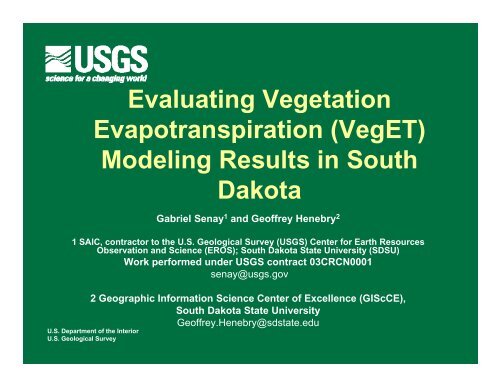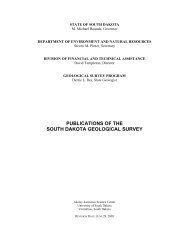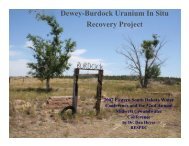Evaluating Vegetation Evapotranspiration - South Dakota ...
Evaluating Vegetation Evapotranspiration - South Dakota ...
Evaluating Vegetation Evapotranspiration - South Dakota ...
Create successful ePaper yourself
Turn your PDF publications into a flip-book with our unique Google optimized e-Paper software.
<strong>Evaluating</strong> <strong>Vegetation</strong><br />
<strong>Evapotranspiration</strong> (VegET)<br />
Modeling Results in <strong>South</strong><br />
<strong>Dakota</strong><br />
Gabriel Senay 1 and Geoffrey Henebry 2<br />
1 SAIC, contractor to the U.S. Geological Survey (USGS) Center for Earth Resources<br />
Observation and Science (EROS); <strong>South</strong> <strong>Dakota</strong> State University (SDSU)<br />
Work performed under USGS contract 03CRCN0001<br />
senay@usgs.gov<br />
2 Geographic Information Science Center of Excellence (GIScCE),<br />
<strong>South</strong> <strong>Dakota</strong> State University<br />
Geoffrey.Henebry@sdstate.edu<br />
U.S. Department of the Interior<br />
U.S. Geological Survey
Outline<br />
• Summary of results<br />
• VegET modeling background and objective<br />
• VegET model outputs<br />
• VegET evaluation<br />
• Soil Moisture (NRCS: SCAN)<br />
• Crop Yield (NASS County)<br />
• Flux Data (AmeriFlux)<br />
• <strong>Vegetation</strong> Water content (AMSR-E VWC )<br />
• NDVI<br />
• Conclusion
Summary<br />
• VegET is a water balance model that produces landscape ET<br />
(water use) on a pixel-by-pixel basis on rainfed systems.<br />
• Correlated well with AmeriFlux latent heat flux (ET) and SCAN<br />
soil moisture data.<br />
• Promising results with crop yield data.<br />
• Show interesting relationship with AMSR-E <strong>Vegetation</strong> Water<br />
Content.<br />
• Operational setup of VegET is possible for crop and grassland<br />
monitoring.
VegET Modeling:<br />
Background and Objective<br />
• VegET is a new modeling approach that integrates Land Surface Phenology<br />
(LSP) and commonly used water balance modeling algorithms to estimate<br />
actual vegetation ET (water use) in primarily non-irrigated crop and grassland<br />
environments for agro-hydrological applications.<br />
• Key inputs to the model:<br />
• 1) Daily rainfall data at 5-km resolution from NOAA/NWS (a new product<br />
since 2005, a blend of NEXRAD and station data)<br />
• 2) Daily reference ET calculated at EROS for global applications from the<br />
Global Data Assimilation (GDAS) climate parameters<br />
• 100 km, downscaled to 10 km<br />
• 3) “Climatological” remotely sensed NDVI time series to define “optimum”<br />
water- use patterns of landscapes throughout the year; 1-km resolution<br />
• 4) Soil water holding capacity from STATSGO (in case of US)<br />
• from 1:250,000 scale soils map<br />
• Objective:<br />
• Produce daily ETa and soil moisture to monitor crop and grassland<br />
performance for early assessment of yield and biomass production.
PRECIPITATION<br />
Reference ETo<br />
VegET<br />
ETa = Ks * Kp * ETo<br />
SOILS<br />
PPT i<br />
Soil Stress Coefficient<br />
Water Balance<br />
ETa i<br />
LSP Water-Use Coefficient<br />
0.8<br />
"Climatological" NDVI Pattern:Nebraska<br />
-97.8, 41.4<br />
0.7<br />
Water<br />
Balance<br />
Model<br />
WHC<br />
Surplus<br />
Runoff<br />
SW i<br />
ETa = ETp ETa = Kp * ETo<br />
ETa < ETp<br />
ETa = Ks * Kp * ETo<br />
Drainage<br />
SW i<br />
= SW i-1<br />
+ PPT i<br />
– ETa i<br />
– RF i<br />
-DD i<br />
NDVI<br />
0.6<br />
0.5<br />
0.4<br />
0.3<br />
0.2<br />
0.1<br />
0<br />
1 3 5 7 9 11 13 15 17 19 21 23 25 27 29 31 33 35<br />
dekad ( 1-36)<br />
Series1<br />
Series2<br />
Series3<br />
Series4<br />
Series5<br />
Series6<br />
Land Surface Phenology<br />
(LSP)
Evaluation Datasets<br />
• Soil Moisture (vol/vol)<br />
• Soil Climate Analysis Network (SCAN): Soil moisture (hourly, July<br />
2005, point), EROS, <strong>South</strong> <strong>Dakota</strong><br />
• Crop Yield (Bu/ac)<br />
• National Agricultural Statistics Service (NASS): (yearly, 2005, 2006,<br />
county-average), <strong>South</strong> <strong>Dakota</strong>.<br />
• Latent Heat Flux (ET)<br />
• AmeriFlux (daily, 2005, Point) Brookings, <strong>South</strong> <strong>Dakota</strong>; also<br />
Arizona<br />
• <strong>Vegetation</strong> Water Content (kg/m 2 )<br />
• AMSR-E (daily, 2005: 25 Km), Faulkton, <strong>South</strong> <strong>Dakota</strong><br />
• NDVI<br />
• AVHRR: (weekly, 2005,2006; 1 km), Faulkton, SD
VegET Model Outputs<br />
Conterminous USA<br />
<strong>South</strong> <strong>Dakota</strong>
Illinois Flash Drought in 2005?
2006 drought in much of <strong>South</strong> <strong>Dakota</strong>, Nebraska, <strong>South</strong>eastern US?
Yearly total shows more water use in the western US.
Seasonal and annual ETa show similar spatial patterns.<br />
Seasonal patterns show more differences in magnitude between<br />
the two years.
VegET: May – Sep
VegET: May – Sep<br />
Major<br />
ETa reduction
VegET Evaluation<br />
Soil Moisture: SCAN Data
Hourly Soil Moisture: EROS SCAN<br />
Hourly Average SM data<br />
SCAN EROS<br />
34<br />
SM (v/V)<br />
32<br />
30<br />
28<br />
26<br />
24<br />
storm event<br />
Day 11<br />
Day 12<br />
22<br />
700<br />
1000<br />
1300<br />
1600<br />
1900<br />
2200<br />
100<br />
400<br />
700<br />
1000<br />
1300<br />
1600<br />
1900<br />
2200<br />
100<br />
400<br />
Hours<br />
hours<br />
on<br />
on<br />
July<br />
11 and<br />
1112, and<br />
July,<br />
12,<br />
2005<br />
2005
90<br />
VegET Soil Water vs SCAN soil moisture<br />
<strong>South</strong> <strong>Dakota</strong> Site, EROS SCAN Site<br />
34<br />
VegET SW (mm)<br />
80<br />
70<br />
60<br />
50<br />
40<br />
30<br />
20<br />
10<br />
0<br />
VegET SW (mm)<br />
SCAN SM (V/V)<br />
1 3 5 7 9 11 13 15 17 19 21 23 25 27 29 31<br />
Days in July, 2005<br />
32<br />
30<br />
28<br />
26<br />
24<br />
22<br />
SCAN Soil Moisture (v/V)<br />
SCAN: Avg of 2, 4, 8, 20 and 40 inch depth data<br />
VegET soil water level change captures the temporal variations in soil moisture<br />
as measured by the SCAN Site.<br />
Note: VegET (5 km), SCAN (Point)
SCAN Soil Moisture (6 am) vs VegET Soil Water Estimate<br />
<strong>South</strong> <strong>Dakota</strong>/EROS Site (SCAN ID 2072) (31 days in July 2005)<br />
VegET Soil Water (mm)<br />
90<br />
y = 7.5618x - 159.68<br />
80<br />
R 2 = 0.9063<br />
70<br />
60<br />
50<br />
40<br />
30<br />
20<br />
10<br />
0<br />
20 22 24 26 28 30 32 34<br />
SCAN Soil Moisture (vol/Vol)<br />
Senay, 2007
Evaluation: Crop Yield<br />
USDA: NASS Data
2005 County Wheat Yield vs Seasonal Total ETa<br />
48 counties in <strong>South</strong> <strong>Dakota</strong><br />
County Wheat Yield vs ETa<br />
<strong>South</strong> <strong>Dakota</strong>: 2005; n = 48<br />
Wheat Yield (Bu/Ac)<br />
70<br />
60<br />
50<br />
40<br />
30<br />
20<br />
10<br />
0<br />
y = 0.0945x + 6.3324<br />
R2 = 0.41<br />
0 100 200 300 400 500 600<br />
VegET ETa (mm) (May – Sep)<br />
Some counties had ETa more than 400 mm
2006 County Wheat Yield vs ETa<br />
46 counties in <strong>South</strong> <strong>Dakota</strong><br />
Wheat Yield (Bu/ac)<br />
70<br />
60<br />
50<br />
40<br />
30<br />
20<br />
10<br />
y = 0.2035x - 31.266<br />
R2 = 0.50<br />
County Wheat Yield vs ETa<br />
<strong>South</strong> <strong>Dakota</strong> 2006; n = 46<br />
0<br />
0 100 200 300 400 500 600<br />
VegET ETa (mm) (May – Sep)<br />
Almost all counties showed ETa less than 400 mm<br />
ETa is better correlated with yield when water is a limiting factor.
2005/2006 County Wheat Yield vs ETa<br />
Counties in <strong>South</strong> <strong>Dakota</strong><br />
Yield (Bu/ac)<br />
70<br />
60<br />
50<br />
40<br />
30<br />
20<br />
10<br />
0<br />
y = 0.1433x - 12.481<br />
R2 = 0.50<br />
County Wheat Yield vs ETa<br />
<strong>South</strong> <strong>Dakota</strong>: 2005 & 2006; n = 94<br />
0 100 200 300 400 500 600<br />
VegET ETa (mm) (May – Sep)<br />
ETa is reliable spatially and temporally
Comparing Yield and ETa Differences<br />
(between 2005 and 2006, county level)<br />
Yield Difference<br />
(Bu/Ac) [2006 - 2005]<br />
Wheat Yield Difference vs ETa difference: 2006 minus 2005<br />
(<strong>South</strong> <strong>Dakota</strong> County Average, n = 36)<br />
40<br />
30<br />
20<br />
10<br />
0<br />
-200 -150 -100 -50 -10 0 50 100 150 200<br />
-20<br />
-30<br />
-40<br />
ETa Difference (mm) [2006 - 2005]<br />
Most counties showed a large drop both in Yield and ETa from 2005 to 2006
Wheat Planted Area Distribution
2005
2006
Possible Sources of Error<br />
• Spatial mismatch<br />
• ETa = county-wide average<br />
• Yield = sub-county aggregate, not all of the counties<br />
produces wheat<br />
• Proposed Solution: use crop layers to redefine ETa average<br />
• Temporal mismatch<br />
• ETa = May – Sep<br />
• Yield = (all seasons total: winter wheat, spring wheat)<br />
• Solution: analyze spring and winter wheat data separately<br />
• Management differences in yield that is not reflected<br />
in ETa (water-base)<br />
• Solution: develop temporal relationship using more years of<br />
historical data and work with yield anomalies.
Evaluation: Latent Heat Flux (ET)<br />
AmeriFlux Data
Latent heat flux (ET) from AmeriFlux tower and VegET ETa<br />
<strong>South</strong> <strong>Dakota</strong>, Brookings<br />
VegETa vs Flux LE: <strong>South</strong> <strong>Dakota</strong> 2005<br />
Cover: crop/grassland<br />
12<br />
0<br />
10<br />
10<br />
20<br />
ETo/ETa (mm)<br />
8<br />
6<br />
4<br />
Flux LE (ETa)<br />
GDAS ETo<br />
VegETa-5k<br />
Flux Rain<br />
30<br />
40<br />
50<br />
60<br />
70<br />
Rainfalll (mm)<br />
2<br />
80<br />
90<br />
0<br />
100<br />
1 20 39 58 77 96 115 134 153 172 191 210 229 248 267 286 305 324 343 362<br />
Days (2005)<br />
VegETa captured both the magnitude and temporal variations of measured flux<br />
at the tower site, including gross primary production (data not shown)
Latent heat flux (ET) from AmeriFlux tower and VegET ETa<br />
Arizona, 2005<br />
VegETa vs Flux LE: Arizona 2005<br />
cover: grassland<br />
12<br />
0<br />
10<br />
ETo/ETa (mm)<br />
10<br />
8<br />
6<br />
4<br />
Flux LE (ETa)<br />
GDAS ETo<br />
VegETa-5k<br />
Flux Rain<br />
20<br />
30<br />
40<br />
50<br />
60<br />
70<br />
Rainfalll (mm)<br />
2<br />
80<br />
90<br />
0<br />
100<br />
1 20 39 58 77 96 115 134 153 172 191 210 229 248 267 286 305 324 343 362<br />
Days (2005)<br />
A stronger correspondence between VegETa and tower latent heat flux.
Evaluation <strong>Vegetation</strong> Water Content (AMSR-E)<br />
The Advanced Microwave Scanning Radiometer - EOS (AMSR-E)<br />
=>passive microwave data (brightness temperature) converted<br />
into <strong>Vegetation</strong> Water Content (VWC)<br />
=>acquired twice daily: pre-dawn and early afternoon<br />
=> 25-km resolution
VegET ETa vs AMSR-E VWC<br />
Faulkton, <strong>South</strong> <strong>Dakota</strong>, 2005<br />
AMSR-E VWC vs VegET ETa<br />
Faulkton, SD 2005<br />
8<br />
0<br />
ETa (mm), VWC<br />
(kg/m2)<br />
7<br />
6<br />
5<br />
4<br />
3<br />
2<br />
1<br />
Rainfall<br />
ETa<br />
ddVWC<br />
dVWC<br />
aVWC<br />
5<br />
10<br />
15<br />
20<br />
rainfall (mm)<br />
0<br />
-1<br />
-2<br />
10-Jan<br />
10-Feb<br />
10-Mar<br />
10-Apr<br />
10-May<br />
10-Jun<br />
10-Jul<br />
10-Aug<br />
Days (7-day Interval)<br />
10-Sep<br />
10-Oct<br />
10-Nov<br />
10-Dec<br />
25<br />
30<br />
ddVWC = dVWC - aVWC<br />
Large negative difference between dVWC and aVWC<br />
seems to occur during optimum water supply and high ET
VegET ETa vs AMSR-E VWC, NDVI<br />
Faulkton, <strong>South</strong> <strong>Dakota</strong>, 2005<br />
VegET ETa vs AMSR-E VWC, NDVI<br />
Faulkton, SD 2005<br />
8<br />
0<br />
ETa (mm), NDVI (x10),<br />
ddVW (kg/m2)<br />
7<br />
6<br />
5<br />
4<br />
3<br />
2<br />
1<br />
0<br />
-1<br />
-2<br />
10-Jan<br />
10-Feb<br />
Rainfall<br />
ETa<br />
NDVI<br />
ddVWC<br />
10-Mar<br />
10-Apr<br />
10-May<br />
10-Jun<br />
10-Jul<br />
Low ETa<br />
10-Aug<br />
10-Sep<br />
10-Oct<br />
Days (7-day interval based on weekly NDVI)<br />
10-Nov<br />
10-Dec<br />
5<br />
10<br />
15<br />
20<br />
25<br />
30<br />
rainfall (mm)<br />
ddVWC = dVWC - aVWC<br />
-Both ETa and ddVWC show immediate stress to low rainfall<br />
-NDVI show similar stress at a lesser degree with a lag time
VegET ETa vs AMSR-E ddVWC<br />
Faulkton, <strong>South</strong> <strong>Dakota</strong>, July 2005<br />
Faulkton: VegET daily ETa vs ddVWC (kg/m2)<br />
2005, July (31 days)<br />
7<br />
ETa (mm), VegET<br />
6<br />
5<br />
4<br />
3<br />
2<br />
y = -2.1925x + 2.6246<br />
R 2 = 0.8465<br />
Physical significance<br />
of this relationship<br />
needs to be<br />
investigated.<br />
1<br />
0<br />
-1.50 -1.00 -0.50 0.00 0.50 1.00 1.50<br />
ddVWC (kg/m2)
Evaluation: NDVI<br />
ETa vs NDVI<br />
Faulkotn, SD (2005 & 2006)<br />
Faulkton, SD (2005 & 2006)<br />
ETa (mm)<br />
8<br />
7<br />
6<br />
5<br />
4<br />
3<br />
2<br />
1<br />
0<br />
ETa2005<br />
ETa2006<br />
NDVI2005<br />
NDVI2006<br />
0.8<br />
0.7<br />
0.6<br />
0.5<br />
0.4<br />
0.3<br />
0.2<br />
0.1<br />
0<br />
NDVI (-)<br />
3-Jan<br />
3-Feb<br />
3-Mar<br />
3-Apr<br />
3-May<br />
3-Jun<br />
3-Jul<br />
3-Aug<br />
Days (7-day interval)<br />
3-Sep<br />
3-Oct<br />
3-Nov<br />
3-Dec<br />
-Both ETa and NDVI show a reduction in 2006<br />
-The relative reduction of ETa is much higher and immediate<br />
than the reduction in NDVI.
Relative Reduction of ETa and NDVI<br />
w.r.t to Crop Yield<br />
NDVI (x 1000) / ETa (mm)<br />
500<br />
450<br />
400<br />
350<br />
300<br />
250<br />
200<br />
150<br />
100<br />
50<br />
0<br />
NDVI (avg) vs ETa (sum)<br />
Faulkton, SD (2005 & 2006)<br />
78% of<br />
2005<br />
2005 2006<br />
Year<br />
95% of<br />
2005<br />
ETa<br />
NDVI<br />
Faulk County: Wheat yield reduction from 2005 to 2006 = 61%<br />
ETa more sensitive to wheat (crop) yield reduction than NDVI
Conclusion<br />
• VegET ETa showed encouraging performance with respect to:<br />
• SCAN soil moisture<br />
• AmerifFlux Latent Heat Flux from Brookings and Arizona<br />
• Non-irrigated county wheat yield<br />
• Interesting relationships between VegET and AMSR-E VWC was observed. The diel<br />
difference VWC (ddVWC) showed a strong negative relationship with ETa. Further<br />
research is required to understand the physical relationship between ddVWC and<br />
ETa<br />
• VegET ETa was shown to be more sensitive than NDVI in detecting yield reduction<br />
from 2005 to 2006.<br />
• Use of historical crop yield data will improve the yield prediction capability of<br />
VegET.<br />
• VegET can be setup to provide daily estimates of sub-county soil moisture, ETa<br />
and crop yield performance and general plant biomass production.<br />
• Caution should be taken in applying VegET on irrigated areas and forested<br />
landscapes that draw water from ground sources or transported surface water.










